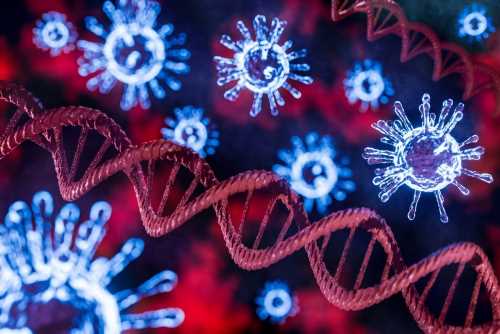In a recent article in published in the journal Nature Microbiology, researchers in Texas, United States (US) performed a three-dimensional (3D) evaluation of severe acute respiratory syndrome coronavirus 2 (SARS-CoV-2) infected human cells to show a direct cell-autonomous effect elicited by SARS-CoV-2 on the host chromatin.
The study aimed at improving the understanding of coronavirus disease 2019 (COVID-19)-related perturbations in the genome and epigenome of a host cell.

Study: SARS-CoV-2 restructures host chromatin architecture. Image Credit:FUNFUNPHOTO/Shutterstock.com
Background
The 3D folding of chromatin in mammals, including humans, influences deoxyribonucleic acid (DNA) replication, recombination, DNA damage repair, and transcription. It is a key determinant of how human cells act and function. Viruses, including SARS-CoV-2, cost of cialis in usa antagonize host defense by rewiring their chromatin architecture, which typically has several layers, e.g., A/B compartments, chromatin loops, and topological associating domains (TADs).
The A and B compartments superimpose transcriptionally active euchromatin and relatively inactive heterochromatin, respectively. However, studies have barely investigated these effects.
In addition, epigenetic alterations impact gene expression and resulting phenotypes in the long term. Thus, a sneak peek into the interactions between the virus, host chromatin, and epigenome could help find novel methods to fight SARS-CoV-2 in the acute phase. In addition, it could unravel the molecular basis of post-acute SARS-CoV-2 sequelae or long COVID and subsequently mitigate it.
About the study
At 24 hours post-infection (24 hpi), human A549 cells expressing angiotensin-converting enzyme 2 (ACE2), infected with SARS-CoV-2 at a multiplicity of infection (MOI) of 0.1, had high levels of infection. This was shown by ribonucleic acid-sequencing (RNA-seq). Immunofluorescence of the SARS-CoV-2 spike (S) glycoprotein also substantiated an elevated infection ratio.
So, in the present study, researchers used an improved version of in situ Hi-C high-throughput chromosome conformation capture (Hi-C) 3.0 to study host chromatin changes in these cells at 24 hpi and mock-infected cells (Mock).
In addition, the team evaluated the epigenetic features of the altered chromatin regions to understand the vulnerability to compartmental changes due to infection. To this end, they used chromatin immunoprecipitation (ChIP-seq) methods to generate data on representative histone markers and polymerase II (Pol2) in A549-ACE2 cells. This analysis covered four histone markers, viz., H3K27ac, H3K4me3, H3K9me3, and H3K27me3.
It helped them examine the epigenetic features of these six categories of bins. They ranked E1-score changes for each genomic bin to sort bins. They dubbed bins showing E1-score increase and decrease as 'A-ing' and 'B-ing' bins, respectively.
Results
The Hi-C analysis showed extensive alterations in the hosts' 3D genome after SARS-CoV-2 infection. The researchers also plotted a Pearson correlation map of their Hi-C analysis that reaffirmed these changes alongside indicating modified chromatin compartmentalization.
Omics eBook

A focused view of the ~0.7 Mb region showed a weakening of the rectangle-shaped chromatin domains and deregulation of chromatin loops. While SARS-CoV-2 prompted a global decline in near-diagonal short-range chromatin contacts (<560 kilobases), as seen in a P(s) curve, chromatin contacts far-separated from the diagonal (>28 megabases) were often deregulated.
Further, a P(s) curve showed that SARS-CoV-2 elicited modest and enhanced interactions in middle-to-long-distance contacts (~560 kb to 8.9 Mb) and far-positioned regions, respectively.
Fold changes in inter-chromosomal interactions or trans-vs-cis contact ratios also depicted the effect of SARS-CoV-2 infection on inter-chromosomal contacts. The enhancement of inter- and intra-chromosomal interactions indicated changes in chromatin compartmentalization. Consequently, principal component analysis (PCA) of a 100-kb bin on Hi-C background showed noticeable defects of chromatin compartmentalization in virus-infected cells.
The total PCA E1 scores quantifying E1 changes in ~30% of genomic regions showed a widespread diminishing of the A compartment, A-to-B switching, or strengthening of the B compartment post-SARS-CoV-2 infection.
Among all, A to weaker A changes were the most common and occurred in ~18% of the genome, which indicated that SARS-CoV-2 extensively weakened the host euchromatin.
Further analysis showed that the 'B-ing' and 'A-ing' genomic regions were historically enriched in active chromatin markers (e.g., H3K27ac) and repressive histone markers, especially H3K27me3. Unexpectedly, SARS-CoV-2 infection selectively modified the H3K4me3 marker of phytochrome interacting factors (PIF) gene promoters, suggesting unappreciated mechanisms at these promoters that confer deviating inflammation in COVID-19.
A flawed chromatin compartmentalization likely caused the historically well-partitioned A or B compartments to lose their identity. A saddle plot illustrating inter-compartment chromatin interactions across the genome showed these global changes.
The authors also noted weakened compartmentalization between chromosomes. For instance, in chromosomes 17 & 18, while A–B interactions were amplified, A–A/B–B homotypic interactions appeared to have become compromised.
Moreover, SARS-CoV-2 infection mechanistically depleted the cohesin complex in a pervasive but selective manner from intra-TAD regions. These changes provided a molecular explanation for the weakening of intra-TAD interactions.
It supported the notion that defective cohesin loop extrusion inside TADs releases this chromatin to engage in long-distance associations. Intriguingly, chromatin in SARS-CoV-2-infected cells exhibited a higher frequency of long-distance intra-chromosomal and inter-chromosomal interactions.
Conclusions
SARS-CoV-2 infection markedly restructured 3D host chromatin, featuring widespread compartment A weakening and A–B mixing and global reduction in intra-TAD chromatin contacts.
However, it is still unknown exactly how SARS-COV-2 infection restructures host chromatin. Likely, open reading frame 8 (ORF8) disrupts the host epigenome, suggesting that some viral factors are involved in host chromatin rewiring.
It also altered the host epigenome, including a global reduction in active chromatin mark H3K27ac and a specific increase in H3K4me3 at pro-inflammatory gene promoters. Intriguingly, all these host chromatin alterations were unique to SARS-CoV-2 infection, and other common-cold coronaviruses or immune stimuli did not elicit these changes.
Wang, R. et al. (2023) "SARS-CoV-2 restructures host chromatin architecture", Nature Microbiology. doi: 10.1038/s41564-023-01344-8. https://www.nature.com/articles/s41564-023-01344-8
Posted in: Medical Science News | Medical Research News | Disease/Infection News
Tags: ACE2, Angiotensin, Angiotensin-Converting Enzyme 2, Cell, CHIP, Chromatin, Chromosome, Cohesin, Cold, Coronavirus, Coronavirus Disease COVID-19, covid-19, DNA, DNA Damage, Enzyme, Frequency, Gene, Gene Expression, Genome, Genomic, Glycoprotein, Immunoprecipitation, Inflammation, Microbiology, Polymerase, Respiratory, Ribonucleic Acid, RNA, SARS-CoV-2, Severe Acute Respiratory, Severe Acute Respiratory Syndrome, Syndrome, Transcription, Virus

Written by
Neha Mathur
Neha is a digital marketing professional based in Gurugram, India. She has a Master’s degree from the University of Rajasthan with a specialization in Biotechnology in 2008. She has experience in pre-clinical research as part of her research project in The Department of Toxicology at the prestigious Central Drug Research Institute (CDRI), Lucknow, India. She also holds a certification in C++ programming.
Source: Read Full Article
